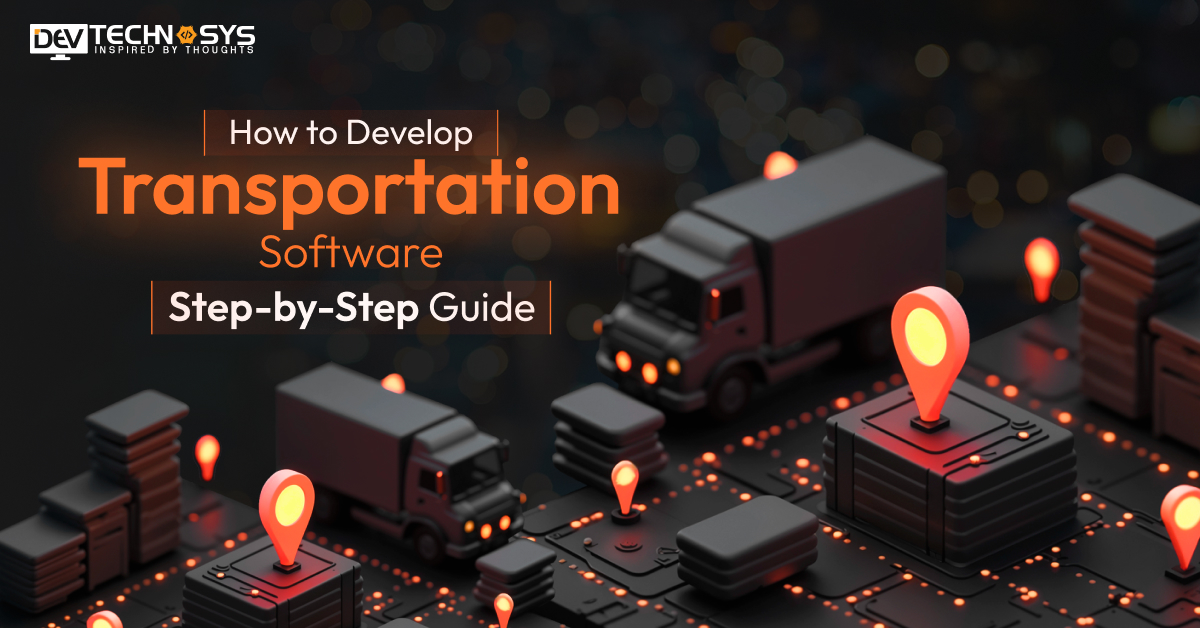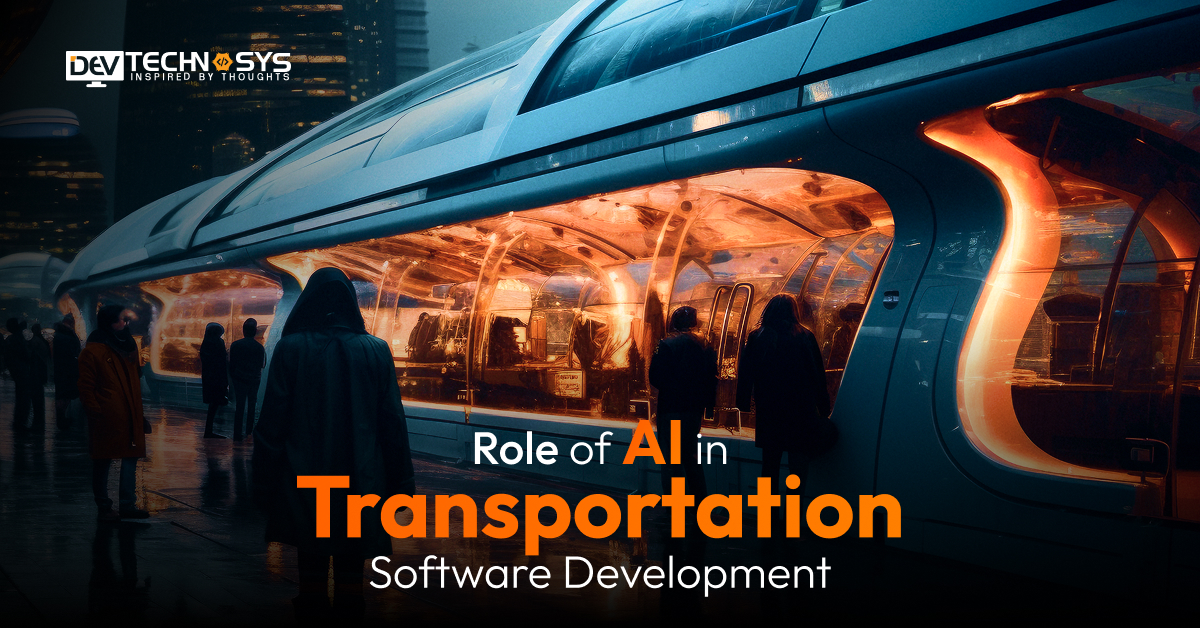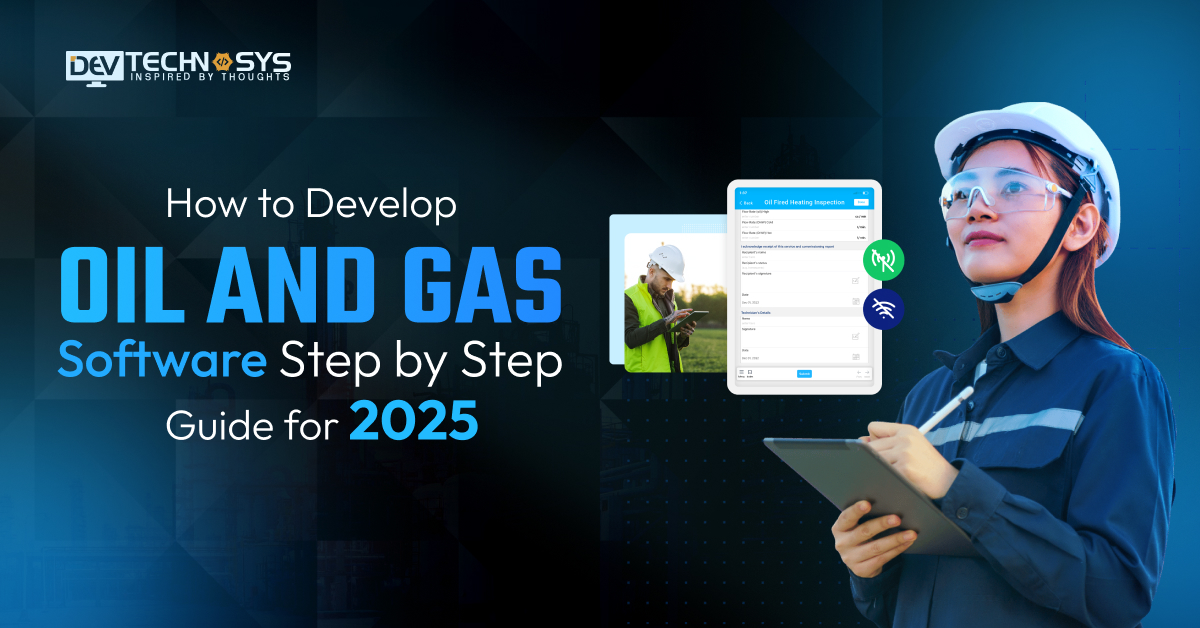“Shift your business growth with transportation and logistics software.”
What does a business need? A consistent workflow, business expansion, and delivery management. The idea to develop transportation software enhanced the logistics industry and improved the UAE product delivery market. As a business investor, there are a lot of opportunities in the transportation industry as it is connected with various domains.
Only in the time gap of 5 years between 2015-2020, this industry crossed the overall revenue and generated a sum of $44.6 Billion. This encouraged businesses to create transportation software and start a new brand.
There are multiple things that entrepreneurs need to understand before investing money. We have discussed all the aspects in this blog.
Current UAE Logistics & Transport Market
A key component of the UAE’s economy, the logistics and transportation industry is fueled as businesses are making investment in building a transportation management system. The sector is expected to increase due to technological advancements and the growing need for effective supply chain solutions.
- Market Size in 2024: The UAE logistics market was valued at $169.7 Billion in 2024.
- Projected Market Size by 2030: Expected to reach $241.6 Billion by 2030.
- Growth Rate (CAGR): Anticipated growth rate of 1% CAGR from 2025 to 2030.
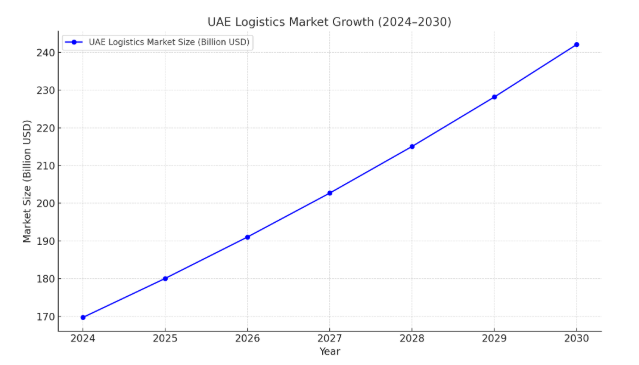
- Share of Global Market: The UAE accounted for 3% share of the global logistics market in 2024.
- Leading Segment: Transportation services were the largest revenue-generating segment in 2024.
What is Transportation Software?
Transportation software is a computerized tool for managing, streamlining, and automating different logistics and transportation processes. Businesses must avail transportation management software development services to manage fleets, plan routes, track shipments, and increase overall productivity.
The integration of logistics software development services with supply chain management may improve customer satisfaction with real-time data and analytics.
- Enables real-time tracking of vehicles and shipments.
- Automates route planning to reduce delivery times and costs.
- Supports fleet management including maintenance and driver monitoring.
Why Invest in Transportation Software Development?
Logistics companies can increase operational efficiency by investing in transportation software. It provides smart tools, automation, and transparency to increase productivity and expansion:
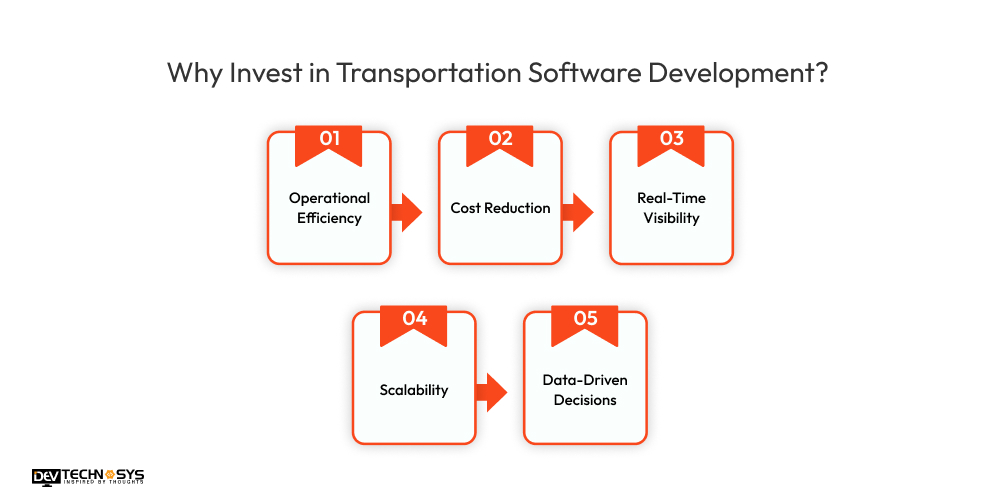
1. Operational Efficiency
Tracking, dispatching, and scheduling procedures are all automated by transportation software. Investment in logistics software development for business reduces human labor and increases workflow accuracy.
2. Cost Reduction
Software helps reduce wasteful spending by managing driver management, fuel use, and routes. Additionally, it lowers administrative overhead and maintenance expenses in logistical operations.
3. Real-Time Visibility
Constant updates on shipment and vehicle status are provided by live tracking tools. You need software development services for better coordination and avoid interruptions occurring in the business growth.
4. Scalability
New routes, expanding fleet sizes, and service expansions can all be readily accommodated by the program. A transportation software development company helps businesses to expand their current systems.
5. Data-Driven Decisions
You must create transportation software for analytics and reporting to offer useful information. These assist managers in making well-informed decisions that enhance productivity and profitability.
Use of AI in Improving Transportation Sector
AI is used to build transportation software to enhance logistical processes and influence the transportation industry. The use of AI in transportation software development increases productivity and lowers operating costs in a variety of applications, including predictive maintenance and route optimization.
Throughout the supply chain, its capacity to instantly evaluate large amounts of data facilitates better customer satisfaction and well-informed decision-making.
- Optimizes delivery routes using real-time traffic and weather data.
- Enables predictive maintenance by analyzing vehicle health patterns.
- Enhances demand forecasting for better resource allocation.
- Improves safety with AI-powered driver behavior monitoring.
- Automates dispatch and load assignment for faster service.
How to Create Transportation Software?
Now, it’s time to understand the process to develop transportation software with detailed information. So, cost management becomes easy and smooth:
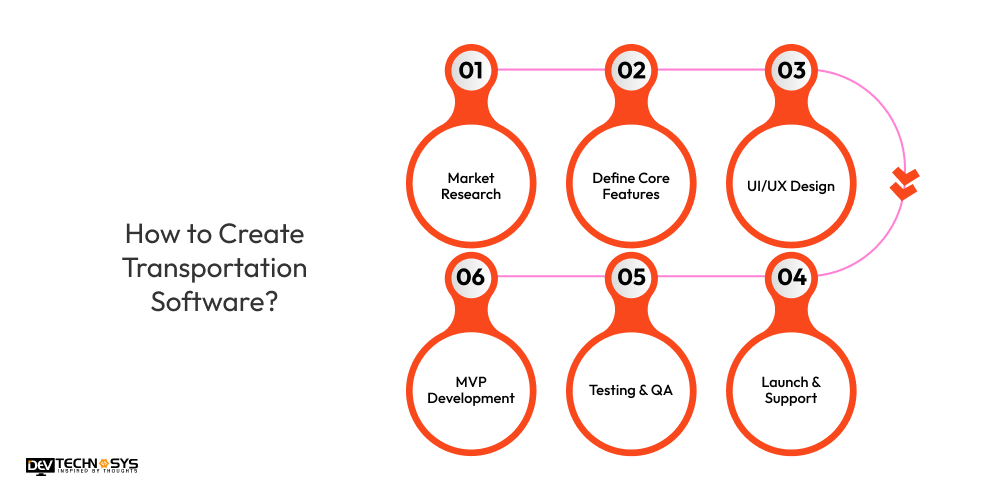
1. Market Research
To build transportation software, start by examining the current technological developments and issues facing the transportation and logistics sector. Determine your target market, including shippers, delivery services, and fleet operators, to learn about their problems.
Examine competitors to identify market gaps and opportunities. Get information about the scalability requirements, compliance standards, and necessary features.
2. Define Core Features
You must include key features like analytics, dispatching, route optimization, and GPS tracking. To create transportation software, it is necessary to select audiences like administrator, driver, or dispatcher, and their particular requirements.
Make sure the feature set satisfies user expectations and corporate objectives. Prioritize features that are essential for the first version and mark more complex ones for later iterations.
3. UI/UX Design
Businesses can make transportation software with a user-friendly and intuitive user interface for mobile and web platforms. To make sure that all users have a smooth experience by using simple layouts and navigation, you must contact a software development company in UAE.
To see the user journey, employ interactive prototypes and wireframes. Take into account each interface screen’s accessibility and responsiveness.
4. MVP Development
Create a Minimum Viable Product with the essential elements required for it to work. Based on your needs for performance, scalability, and integration, pick an appropriate tech stack. Maintain the backend architecture’s adaptability for upcoming changes.
For iterative progress and feedback inclusion, approach a transportation app development company. With this strategy, you can test with actual consumers and launch rapidly.
5. Testing & QA
Test each module’s functionality, usability, performance, and security. Verify compatibility across platforms and devices to guarantee a consistent user experience. Prior to release, find and address any flaws, malfunctions, or inconsistent user interface.
To make sure the program can manage large amounts of data and traffic, run stress tests. QA contributes to the delivery of a reliable, secure, and well-designed product.
6. Launch & Support
Install the program in the cloud, on-premises, or hybrid hosting environment of your choice. Real-time performance monitoring and user input collection are essential for enhancements. To help users, provide documentation, customer support, and onboarding assistance.
Use transportation software development services to release security patches and bug fixes. Long-term dependability and user satisfaction are guaranteed by post-launch support.
Incredible Features of Logistics Software
Advanced features that increase delivery efficiency, save costs, and streamline processes are all included in logistics software. These tools guarantee supply chain visibility and control from beginning to end:
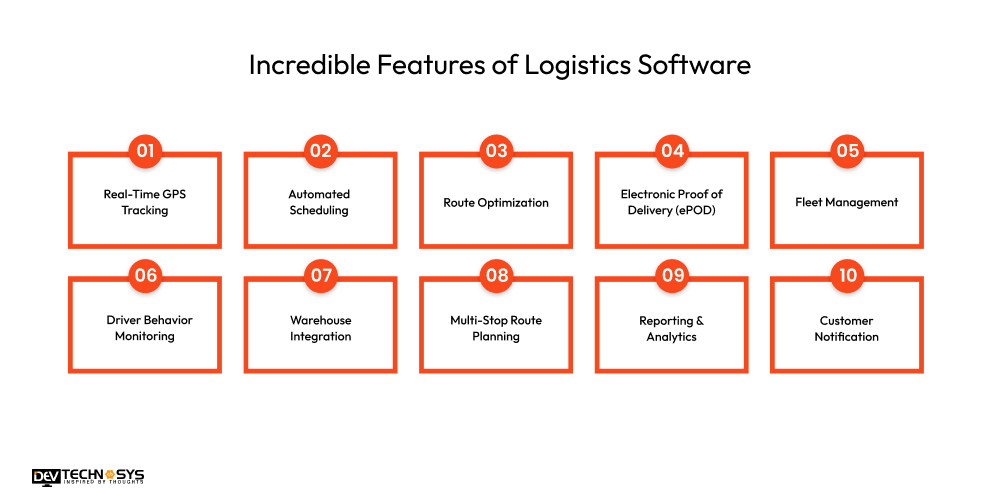
1. Real-Time GPS Tracking
Enables live tracking of vehicles and shipments on an interactive map. It enhances transparency, reduces delays, and improves delivery coordination.
2. Automated Scheduling
Automatically assigns drivers and vehicles based on availability and priority. This reduces manual planning time and ensures timely dispatch of deliveries.
3. Route Optimization
Calculates the most efficient delivery routes using traffic, distance, and time data. You must develop logistics software that helps to reduce fuel costs, delivery times, and vehicle wear and tear.
4. Electronic Proof of Delivery (ePOD)
Captures digital signatures, photos, and timestamps upon delivery. It eliminates paperwork, prevents disputes, and ensures accountability.
5. Fleet Management
Monitors vehicle health, maintenance schedules, fuel usage, and location data. You can build a transportation app like Aramex that keeps operations running smoothly and improves vehicle lifespan.
6. Driver Behavior Monitoring
Tracks driving patterns like speed, harsh braking, and idling time. Improves safety, reduces risk, and encourages responsible driving habits.
7. Warehouse Integration
Connects with inventory and warehouse systems for real-time stock updates. You may build transportation software that ensures seamless order processing, packing, and loading coordination.
8. Multi-Stop Route Planning
Enables optimized planning for routes with multiple delivery or pickup points. The idea of implementing transportation management system saves time and fuel while meeting customer priorities.
9. Reporting & Analytics
Provides actionable insights through custom reports and KPIs. Businesses may build a custom transportation management system that helps managers to make data-driven decisions.
10. Customer Notification
Sends real-time alerts and updates about delivery status and estimated arrival time. Enhances customer satisfaction and reduces support inquiries.
Various Types of Transportation Software
There are various types of transportation software available to handle particular logistics issues. These tools improve control and efficiency from fleet management to freight and route optimization:
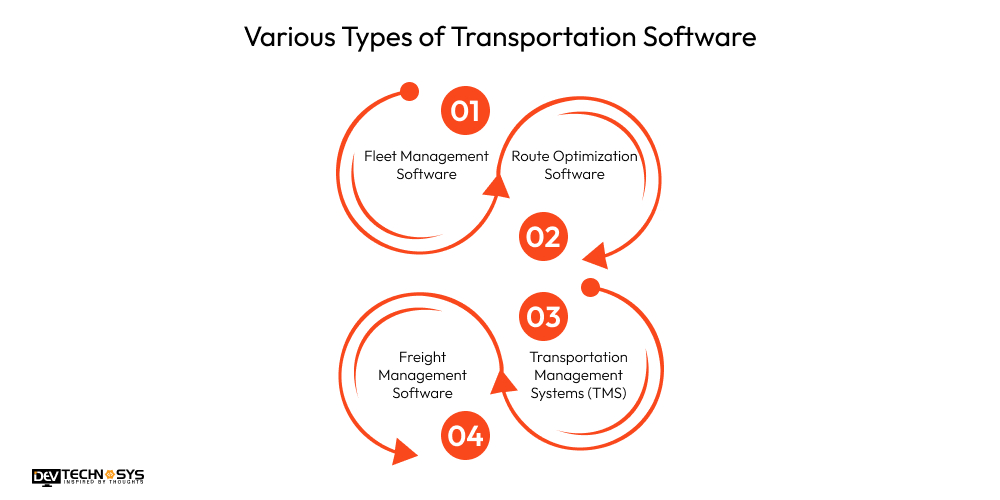
1. Fleet Management Software
It monitors and controls the performance of drivers, cars, fuel consumption, and maintenance plans. Businesses may build logistics and transportation software for compliance and operational efficiency.
- Vehicle Tracking & Telematics
- Maintenance Alerts
2. Route Optimization Software
The software uses real-time traffic and location data to determine the most efficient delivery routes. This increases delivery accuracy and lowers fuel usage and travel time.
- Dynamic Route Planning
- Multi-Stop Sequencing
3. Freight Management Software
They oversee the transportation, scheduling, and recording of goods via a variety of means. Businesses may use mobile app development services to improve freight cost, increase visibility, and streamline shipping operations.
- Shipment Tracking
- Rate Management
4. Transportation Management Systems (TMS)
It is a complete platform that manages transportation-related planning, execution, and optimization. You may build TMS software that provides end-to-end logistics automation and integration with carriers, WMS, and ERP.
- Order & Load Management
- Carrier Integration
Top 5 Transportation Software in UAE
Modern software is essential to the UAE’s expanding logistics and transportation sector that improve visibility and business processes. These are the top five transportation software programs:
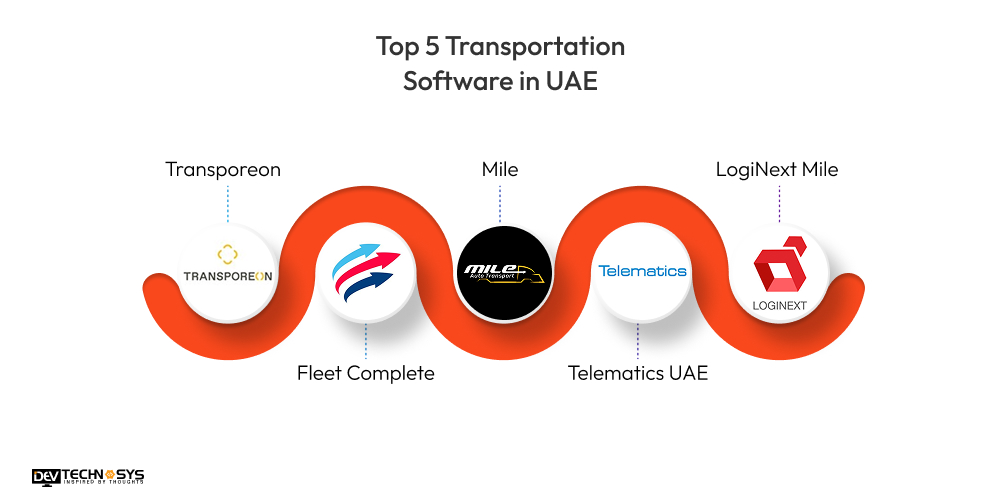
1. Transporeon
A cloud-based platform that facilitates end-to-end freight execution by linking suppliers, carriers, and shippers. For increased efficiency, it provides freight settlement tools, real-time visibility, and transport assignment.
- Transport Assignment Automation
- Real-Time Freight Visibility
2. Fleet Complete
An all-in-one workforce, asset, and fleet management system for delivery and logistics companies. For optimal fleet performance, it offers GPS tracking, vehicle diagnostics, and driver behavior analysis.
- Comprehensive GPS Tracking
- Driver Behavior Monitoring
3. Mile
This is a platform for managing last-mile deliveries designed for on-demand and hyperlocal companies. The use of AI in transportation has automated dispatching, real-time tracking, and route planning.
- Automated Dispatching
- Real-Time Delivery Tracking
4. Telematics UAE
A local company that offers fleet telematics and GPS tracking solutions that are customizable. It assists companies with vehicle monitoring, compliance assurance, and fuel and maintenance cost reduction.
- Customized GPS Tracking Solutions
- Fuel Usage Monitoring
5. LogiNext Mile
It is a field service, courier, and last-mile delivery management software powered by AI. You may develop a transportation app to increase delivery efficiency and provide real-time tracking with route optimization.
- AI-Powered Route Optimization
- Customer Notification System
How Users Benefit from Transportation Software?
Businesses can make transportation software to greatly enhance logistical operations. It improves the supply chain’s overall speed, visibility, cost-effectiveness, and service quality:
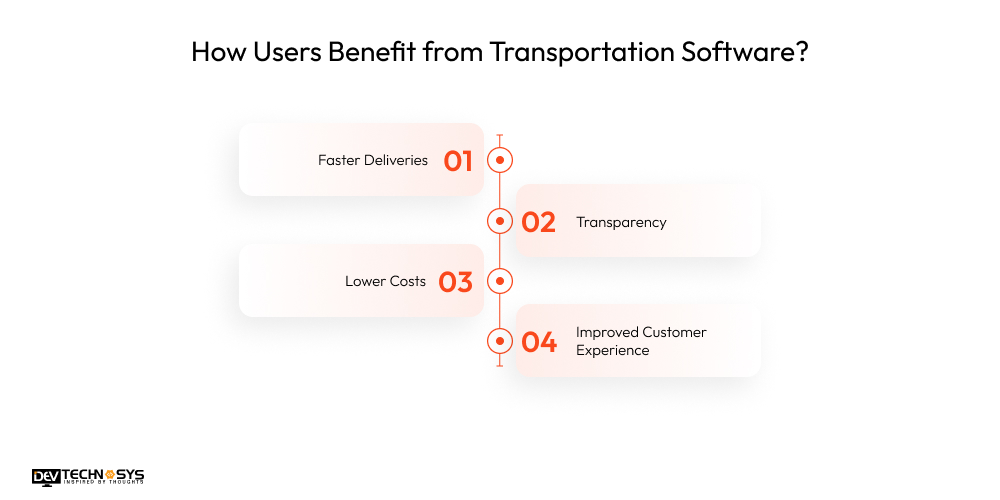
1. Faster Deliveries
Real-time dispatching and intelligent route optimization cut down on delivery times and delays. You may build transportation software for better fleet utilization and on-time delivery to increase user satisfaction.
2. Transparency
Users get complete visibility into the movement of their shipments thanks to live GPS monitoring and status updates. In the event of delays or problems, it enables proactive communication and fosters trust.
3. Lower Costs
Fuel consumption, work hours, and idle time can all be decreased by automating manual procedures. A software development company helps to reduce operational faults, allocate resources, and save costs.
4. Improved Customer Experience
Customers are kept informed through smooth communication, delivery alerts, and accurate ETAs. Investment in transportation management system development guarantees a dependable logistics experience that increases user happiness.
Tech Stack Used for Developing Transportation Software
To build transportation software that guarantees performance, scalability, and real-time capabilities, you require a flexible tech stack. Effective data handling and smooth GPS with third-party service connectivity are all made possible by the correct tech stack.
Component |
Popular Tools/Technologies |
| Frontend Framework | React, Angular, Vue.js |
| Backend Framework | Node.js, Django, Spring Boot |
| Mobile Development | Flutter, React Native, Swift, Kotlin |
| Database | PostgreSQL, MongoDB, MySQL |
| Cloud Services | AWS, Google Cloud, Microsoft Azure |
| Real-Time Communication | WebSocket, MQTT, Firebase Realtime Database |
| GPS & Mapping APIs | Google Maps API, Mapbox, OpenStreetMap |
| Containerization | Docker, Kubernetes |
| CI/CD Tools | Jenkins, GitHub Actions, GitLab CI/CD |
| Security | OAuth, JWT, SSL/TLS |
What is the Cost to Develop Transportation Software?
The cost to develop transportation software is determined by a number of strategic and technical factors. A number of factors are important, including design, maintenance, team makeup, and functionality. You can set a reasonable budget and timetable for your project by being aware of these:
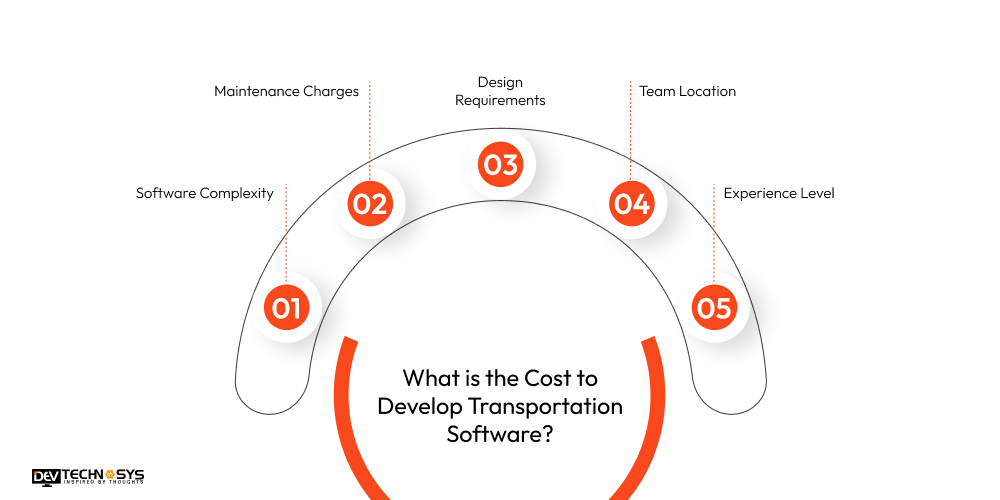
1. Software Complexity
The cost to build transportation software increases with the number of features and modules like real-time tracking, dispatching, and analytics. Additionally, complex systems take longer to code, test, and integrate. Compared to simple apps, custom solutions that use AI or automation are more expensive.
Software Complexity |
Development Time |
Estimated Cost |
| Simple | 2-5 months | $5000-$10000 |
| Moderate | 5-8 months | $10000-$15000 |
| Complex | 8-12 months | $15000-$20000 |
| Premium | More than 12 months | $20000-$25000 |
2. Maintenance Charges
After launch, ongoing server maintenance, software updates, bug patches, and support are crucial. The rate of maintenance is around 15–20% of the entire transportation app development cost. More expensive maintenance plans are needed for advanced systems like cloud infrastructure.
Component |
Estimated Cost |
| Bug Fixes & Updates | $2,000 – $5,000 |
| Server & Hosting Management | $1,500 – $4,000 |
| Security Patches & Support | $1,000 – $3,000 |
3. Design Requirements
Building highly personalized and user-friendly interfaces requires more effort and money. The cost to develop transportation software is increased by design sophistication such as flexible layouts, dashboards, and animations.
Component |
Estimated Cost |
| UI/UX Wireframing | $1,000 – $2,500 |
| Interactive Prototypes | $2,000 – $4,000 |
| Responsive Design | $1,500 – $3,500 |
4. Team Location
Hourly rates are higher for development teams in places like Western Europe or North America. The transportation software development cost is decreased by hiring offshore teams from nations like the Philippines, India, or Ukraine.
Team Location |
Estimated Cost |
| USA | $25000-$30000 |
| Australia | $20000-$25000 |
| India | $5000-$12000 |
| UK | $15000-$20000 |
| UAE | $8000-$15000 |
| Brazil | $12000-$16000 |
5. Experience Level
Compared to junior or mid-level professionals, senior coders and skilled UI/UX designers earn greater prices. Teams with more experience create projects more quickly and guarantee fewer errors which increases the transportation software development cost.
Experience Level |
Cost Estimation (USD) |
| Junior/Entry-Level | $8000-$12000 |
| Mid-Level/Experienced | $12000-$16000 |
| Senior/Expert | $16000-$20000 |
| Professional | $20000-$24000 |
How to Make Revenue Through Transportation Software?
Businesses can make transportation software that may provide numerous revenue streams. Every kind of income, including licensing, ad revenue, and recurring plans, can generate steady income:
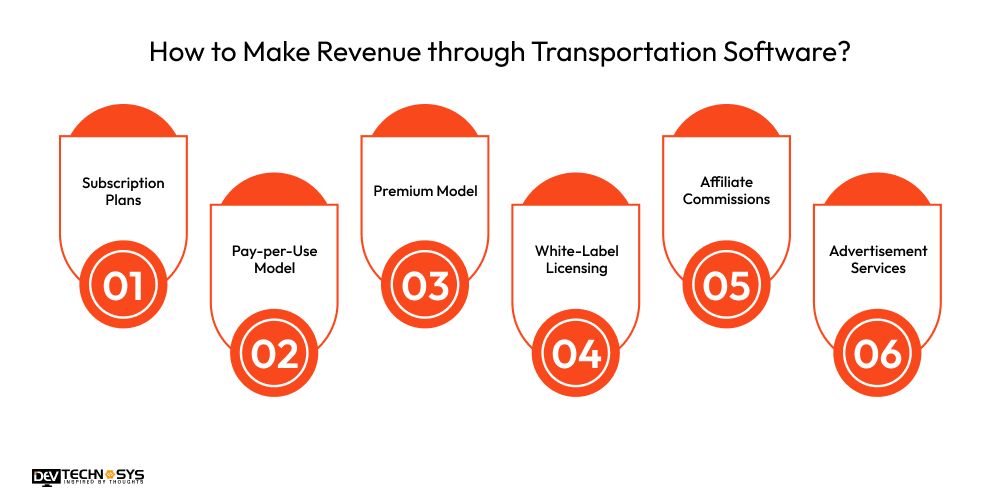
1. Subscription Plans
Provide subscription plans that are dependent on user tiers or features. This attracts companies that require continuous assistance and guarantees steady income. To balance the cost to build transportation software, you can provide basic, pro, and enterprise options.
2. Pay-per-Use Model
Users are billed according to utilization indicators such as the quantity of deliveries, trucks controlled, or distance traveled. Startups and expanding businesses find this model appealing since it is adaptable and scalable. It promotes increased use without tying customers to long-term agreements.
3. Premium Model
Offer a feature-limited free version and charge for access to more expensive tools. Paying users may be granted access to more advanced analytics, automation, and integration tools. This strategy helps in managing the software development cost by increasing the number of paying clients.
4. White-Label Licensing
Give your software to resellers or logistics firms who wish to rebrand it under their own name. It enables you to scale the reach of your platform and generate substantial one-time or recurring fees. For B2B expansion without overseeing direct customer service, this is perfect.
5. Affiliate Commissions
Join forces with service providers such as maintenance firms, insurance companies, or gasoline cards. Get paid when you direct users to these partners via your platform. Without increasing the cost of your product, this generates passive income and gives users more value.
6. Advertisement Services
Provide similar companies aiming to reach logistics firms with ad positions in your software. Show advertisements on dashboards where logistics managers spend time or in free versions. If you have a sizable user base or use a freemium business strategy, it’s a helpful source of revenue.
In a Nutshell!!
Entrepreneurs may now easily invest money to make transportation software as we have discussed all the major topics related to the development. To get effective services and an experienced development team, approach Dev Technosys, a mobile app development company in UAE. it offers:
- Comparison model to list core features.
- Methods to reduce the cost to develop transportation software.
- Ways to make profit and increase user engagement.
- After-launch support and maintenance services.
A business investor needs all these benefits to easily start an online logistics business by introducing software that makes processes smooth and operational.
FAQs
1. Which is the Best Software for Transportation in UAE?
LogiNext Mile is among the top transportation software programs available in the UAE. It provides real-time analytics, route optimization, and sophisticated last-mile delivery tracking.
2. How Long Does it Take to Develop Transportation Software?
Transportation software development typically takes 4 to 9 months. While a complicated system takes longer, a basic MVP with fundamental capabilities can take 3 to 4 months.
3. What is the Maintenance Cost of Freight Management Software?
Annual maintenance expenses usually fall between 15% and 20% of the original development cost. Bug fixes, performance enhancements, server maintenance, and new feature improvements are all included in this.
4. How to Optimize Transportation Software Development Cost?
- Focus on building a Minimum Viable Product.
- Leverage frameworks like Flutter with a single codebase.
- Outsource skilled developers from cost-effective regions.
5. Do Transport Software Ensure User Data Security?
Yes, access control, authentication, and robust encryption are implemented by the majority of transport software platforms. Reputable providers also frequently comply with data protection regulations like GDPR.



